-
Posts
590 -
Joined
-
Last visited
Content Type
Profiles
Forums
Articles
Gallery
Downloads
Events
Posts posted by Dave Budd
-
-
I don't make ladles, but I do make spoons and I have a friendly fabricator cut blanks out of 6mm sheet with his cnc plasma cutter :) I expect if I were to make ladles he would be able to do me a run of blanks with the handles or a stub that would start the handle pretty reasonably and aside from the forging needed I would have whatever shape I actually want
-
I know this isn't new to some here, but it's been on my mind to have a go at for years, but I have only just today gotten to it. So like an excited child I had to show everybody on a couple of other forums my new trick ^_^ So this was also written for folk not 'in the know', I just copy and pasted it (because I'm also lazy!).I've used wrought iron and shear steel in some of my knives for years, but have only helped out with smelts and am yet to commit myself to running one (huge investment in time and materials with the risk of it going totally Pete Tong! :o ). So today instead of tidying the workshop in preparation for a course, I built an Aristotle furnace. For those that don't know what it it is, an Aristotle furnace is a tiny furnace for remelting bloomery or scrap iron. The resulting material is similar to bloomery iron (or steel) but cleaner, similar to the Japanese Orishamagani (or however it is spelled!). It is also very quick and cheap to run! Skip Williams and Lee Sauder (A couple of clever American blacksmiths) came up with the concept years back and I have been meaning to have a go for years :rolleyes:So here is my first attempt!The furnace was built around a large Coke bottle and made from the clay that my workshop is sat in. Normally the clay would be tempered with dung, but I wondered how well it would stand up without it (I've used it this way for forges for years afterall). On the most part, not too badly but I will add some organic matter next time. I found a small blower in a corner that I bought years ago because it would 'come in handy one day'. Once it was good and hot, I started feeding in some crappy mild steel barstock from my rusty pile in the corner.As one bar sank below the coals, another was fed in. I stopped when all 699g of rusty iron was gone. I was a little impatient and probably started feeding a little early, so it took about 45 minutes for all of the metal to be consumed by the fire. I let the charcoal burn down a bit and then tried to remove the mini bloom from the bottom. Unfortunately it was stuck fast and I cracked the furnace in trying to get it out. So I hit it with a hammer and did a Blacksmiths' Caesarian on it! :DKnocked the furnace walls from the bloom. It seemed pretty solid at this point and ice and heavy, so I could be certain that I had metal!While it was hot and instead of going home to walk the dog (sorry Saxen!), I lit the coke forge and hit it some more. What can I say, I'm a kid that wants to stay out playing a bit longer!and because its a cool picture:At this point I have just worked it on all sides to consolidate it a bit and weld any loose bits together. It welded absolutely fine and with virtually no cracking apart, so I'm a happy bunny thus far. It feels fairly stiff, lets see what the sparks sayYeah baby! :D:D 8)Then I really did have to go home :( I'm now tied up teaching and demonstrating until next thursday! So I don't get to see how it forges and what it will become until the end of next week!Oh incidentally, after consolidation into this bar; the 699g of mild has become 415g of higher carbon steel :) I'll be doing this again!
-
now Colleen mentions it, I think maybe I just had Parkers in my mind as a humerous price comparison. Like I say I don't buy much mild (one delivery every 2 - 3 years normally), so mostly I get small quantities from friendly smiths and fabricators locally who can add an odd couple of lengths to an order for me. I get more regular deliveries of tool steels, but that lot comes from a few stockholders in the Sheffield area due to the specialist nature of the grades asked for :)
-
I don't use a great deal of mild steel, but when I do buy it I (think) it is from ASD Metal Services in Exeter. I've also had some stuff from Parker Steel in Exeter. On occasion when I only need small amounts (and thus don't want to pay for the delivery charge), I get it added to a friendly fabricator near by and he cuts it into car-lengths for me :)
-
assuming dates work out, then count me in :)
-
I would be inclined to just get a load of them plasma or laser cut from 2mm or 3mm plate! Much easier than forging them and if you need 100+ then much cheaper for the customer too ;)
-
are you wanting to grind an internal or external bevel on the hooked blade?
I make a lot of spoon carving hooks with an external bevel and they are fairly simple. First I use a small contact wheel on my belt grinder to flatten the inside surface off, before I made the wheel I used a Dremel with a sanding drum. Then to put the external bevel on I set the table up at an angle to the platen on my grinder and just run the blade along it, assuming the blade back is flat to the table I get good consistent bevels.
On internal bevels such as the Motugan style crooked knife (which I rarely make coz they are a pain in the rear and I don't think work very well anyway!), I find it easiest to grind the bevel most of the way before bending it into a hook (ie on a straight blade). That way I have the bulk of the steel out of the way and there is a guide angle to work from when I come to post heat treat grinding. After the heat teat I have used said dremel with sanding drums to finish off and a small grinding wheel in Dremel to grind off the bulk. Slow, tedious and not as good as I would like, but it does work. I expect the small contact wheels that I made for spoon hooks and gouges would work too, but I haven't made this style of blade in a long time.
The other option for internal bevels is to grind befoe bending as described, then after heat treat remove the decarb ith sanding drum on dremel, but do the bulk grinding from the outside on the flat 'back'. That would mean starting with a 4mm thick bar if you want a 3mm thick blade, but might be easier than trying to grind an internal bevel fully o risking thinning the edge too much before heat treat
-
Owen Bush (Basher on here) has made a few prods for cross bows. Dangerous things to get wrong!
-
I use the shinto saw rasps all the time, they are fantastic! I didn't realise they were an older design :) The new ones are thinner and double sided, but are great on wood, plastic, non-ferrous and even mild steel (though metals will dull them faster of course)
-
i oil handles when I make them, but in use i've not bothered. Never had problems with them drying out, with only one exception and that was an old handle anyway (by old, I mean older than me). Chisels and hammer faces get ground as I need them or just before a course when it comes to my teaching set (they get chewed up quickly, but better that than my anvils!).
I do occasionally procrastinate by building that tool rack though :)
-
Well, my block gets used :) I think I've already mentioned some of the uses that I have found for it earlier in this thread. I've also started using a few elements of it for making tapered ferrules.
I agree that the veining doesn't work, but it was an experiment after all. I may grind it off and make a very shallow round swage in there instead. I've still not got around to dressing it properly, just enough to do what I need it to do. The only damage it has sustained are a couple of small dents caused by errant blows with the cross peen of a hammer whilst beating a piece of tool steel into spout swage (making an auger), nothing more than would appear on an anvil or any other swage
All in all, a good solid tool. still :)
-
if you're looking for classes to learn swordsmithing then your best bet would be to give Owen Bush a call. He runs courses making them from his forge on London ;)
-
i've never found a glue that will stick well to copper or brass. silicon type sealants (like the sort of thing that Hofi uses on his hammers) is about as good as I've found, and they wobble a bit due to being flexible adhesives.
Recently I've got around the issue by soldering or brazing pins or a lug on to the sheet of metal and glueing that into a hole in the wood (with keys cut into the side of the pins). Maybe that's an option for you?
-
i use an auto darkening helemt too and I've found that the flash is worse when the sun comes out. I reckon that its got something to do with the ambient light levels too. I've mostly got around it by turning the shading up on the helmet when its bright in the workshop (I have skylights and only work during the day).
-
i play a variation f the game that Everything Mac mentions. We have 2" nails with very small (3mm) heads and a stupidly small hammer (face of about 8mm), all other details are pretty much the same. Depending on whether the drinking aspect of the rules ins involved, I have done it in as little as 4 goes and as many as total fail. Oh, I'm also mean as I always use oak for the log :D
A few other games I've come across:
drawing out a 50mm section of 12mm bar to as long as possible in a set time. So like the 2" one about, but a solo competition
throwing hammers at a 'sword' (2"x3' bar) stuck in the ground 5yds away. The hammers ranging in size from pin hammers to sledges
'Kissing the hammer'. holding a hammer in front of you at full extension and tilting it towards your face to kiss it (so just bending at the wrist not you shoulder or elbow). The winner is the one who can kiss the biggest hammer without breaking their nose!
-
welcome aboard neighbour :)
I don't get to many of the meets, but I do try to get to some of the IFI get together than John puts on at Westpoint. Enjoy the forging
-
I've got a woefully inadequate drill press when it comes to drilling holes any larger than 1/4" in steel, and since I mostly work with tool steels I have had to learn how to sharpen bits (saved me a fortune!). Regrindin the normal hss twist bits certainly makes them cut better (and faster), assuming that you sharpen them properly. I've not gotten around to trying cobalt drills, but have recently picked up tct tipped ones when a normal jobber drill won't cut it. The main problem I've had with the tipped ones is that a little too much pressure and the tips shear straight off! :( But get it right and they cut hardened steel like nothing else I've used.
On a side track, slightly. Due to the girly machine, I've discovered the easiest way to drill holes over 1/4 (or even smaller holes in hardened steel before I found the tct tips) is to regrind a masonry bit. I regrind the double beveled edge into a scraping edge and use higher revs than normal and they work a treat, less resistance in the material and the hard cutting edge. I don't know why the tct twist bits I have arn't constructed the same way as the masonary bits because I've not managed to strip them in the same way?
-
i don't have any pictures to hand, but they are very simple in this case. The top tool is just a flat disc of steel with a shank to fit the press, I bought it on ebay and suspect it was made as a flatter or somesuch. The bottom tool is just a flat block of steel that acts as an anvil.
I do have a set of V-swages that I use for squaring billets up and for welding difficult billets from all sides at once, but that wasn't used here.
-
-
i'll be there as well, with a table or three of sharp and possibly shiny things :)
-
I had a chap on a course last year who wanted to turn a piece of damascus barrel into a blade. We cut it down the length, opened it out and forged it flat. Jut as well I decided to test a bit to make sure it would harden up, because it didn't! So we welded a piece of it either side of a bit of tool steel and made the blades that way :-)
-
i can vouch for that :( My workshop is not only i the middle of nowhere, which is not ideal from a safety perspective (air ambulance territory here), but also my workshop is 200yds from the road and the only access is by tractor through a wet field. Any deliveries have to be in smallish lorries and met at the roadside, so couriers have call me when they get close. Also power is a problem. At least in a farm building there are decent yard spaces, turning spaces, heavy duty mains power etc
-
I do all of my punching and cutting with the bar between my legs, I just make sure that the bar is properly hot before I do anything ;) When you first get the metal between your legs, hit it smartly with the hammer so that the end you are working n bends and rests on the anvil surface. That way you can work on anvils that are too tall or too low as well as making sure the metal is hot enough to work on
-
i think what admanfrd means is that the handle was excessively long for the technique used. Like you say Brian, yourself, Hofi, etc hold the heavy hammer quite close to the head (I do the same), but the handle on Hofi's hammers at least are pretty short since there is no need for a 14" shaft.
I suspect that the visitor had just fitted a handle that he had lying about and it just happened to be much longer than needed ;) I doubt there would be a counter balance argument such as with some axe handles. I have cut a few of my handles down on account of them getting in the way when in use at shows (where I am working on a low anvil and I am prone to hitting the log in certain situations)


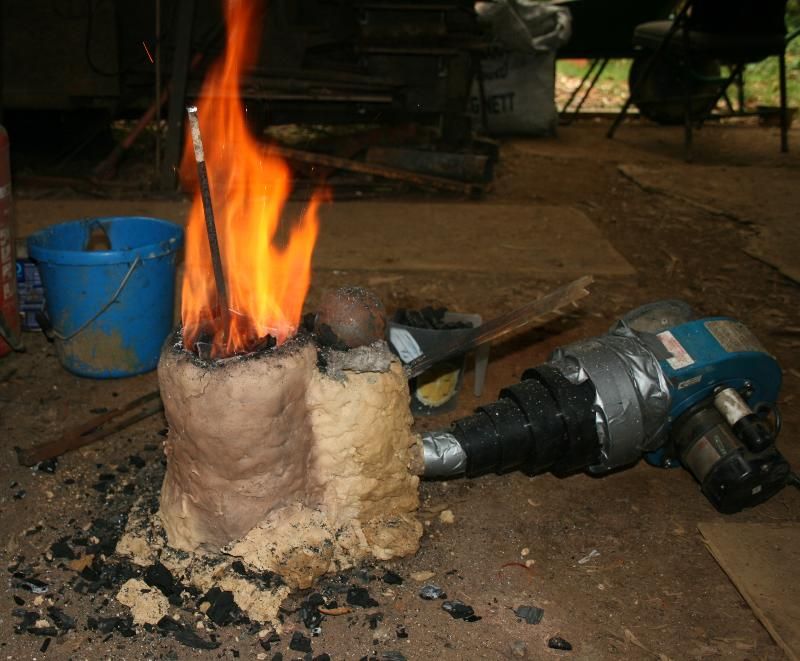
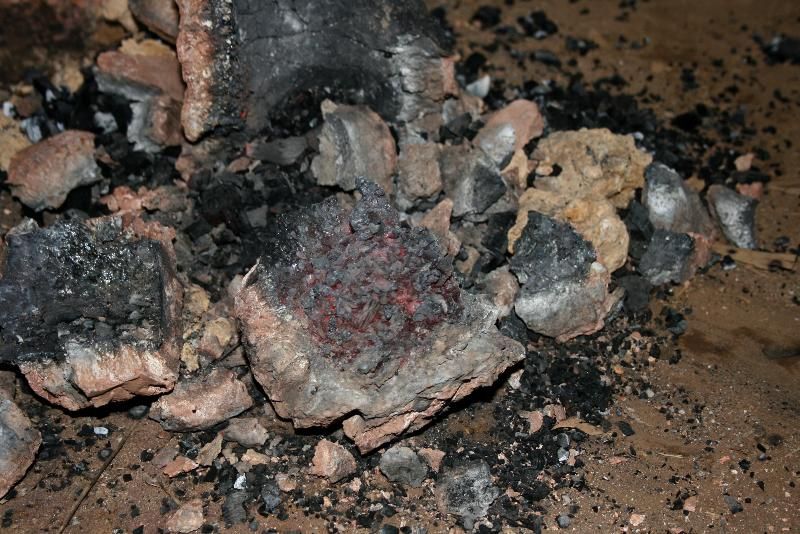
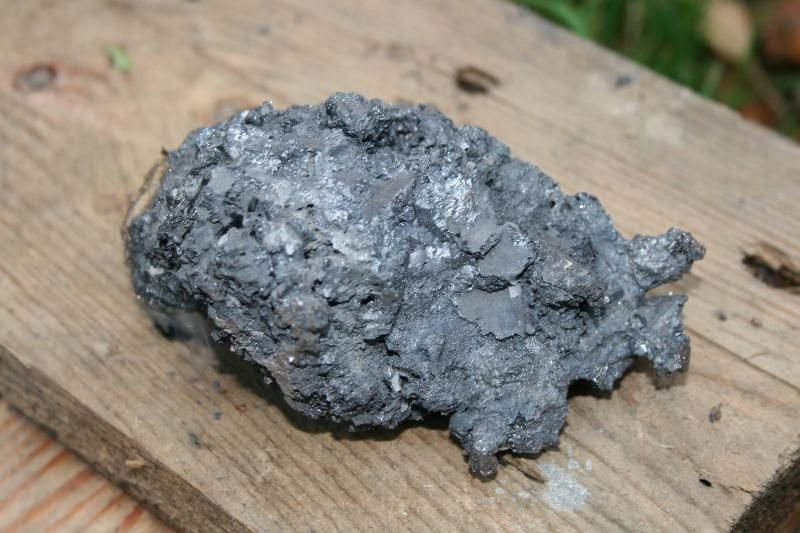
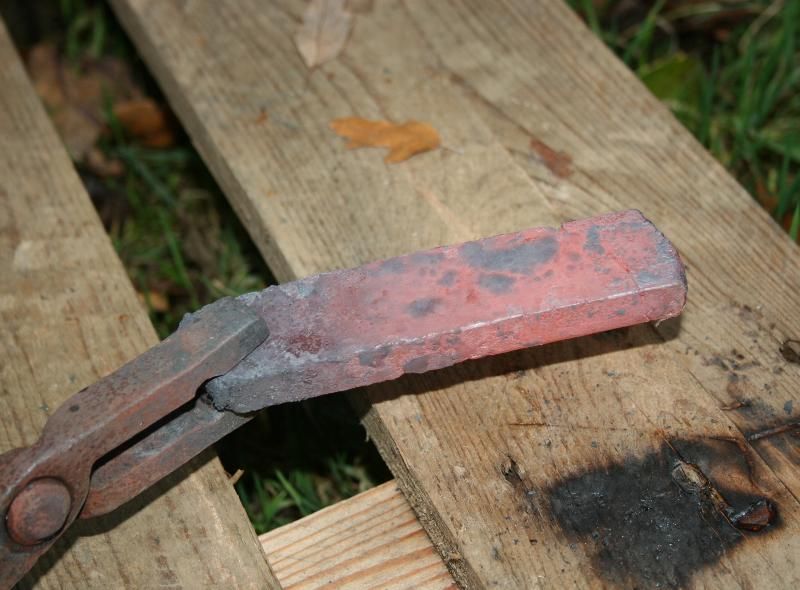

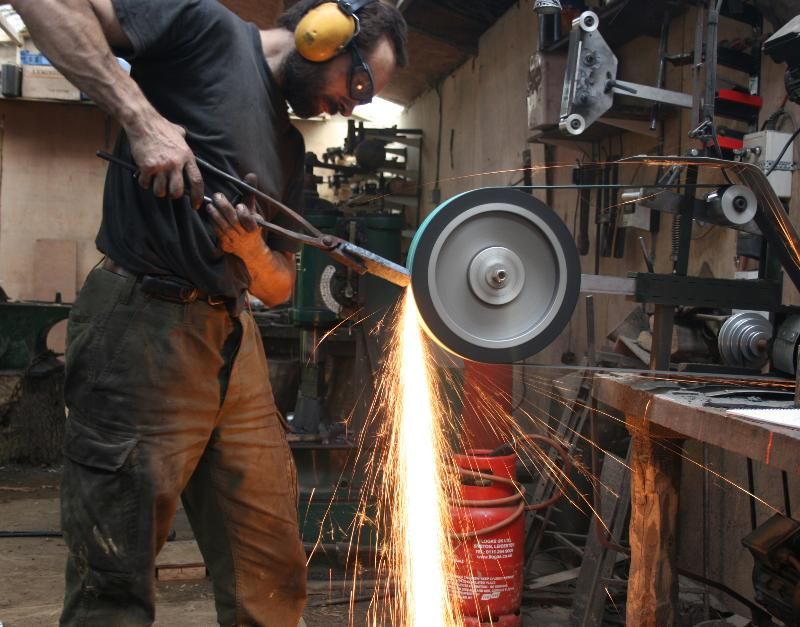


Steel for hammer dies
in Power Hammers, Treadle Hammers, Olivers
Posted
really? I've cut lots of bits of fork lift and I've used my horizontal bandsaw (nice sharp blade helps) and angle grinders before I got the saw.